Calculation Theory of Counterweight Double-Row Pile Support for Deep Foundation Pit in Reclamation Area and Influence Analysis of Core Pile Parameters
Abstract
:1. Introduction
2. Background
2.1. Engineering Situation
2.2. The Design Scheme of Pile Row
3. Design Theory Analysis of Counterweight Double-Row Pile
3.1. Calculation Model
3.2. Model Construction and Parameter Selection
4. Results and Discussion
4.1. Comparative Analysis of Simulation Results and Monitoring Data
4.1.1. Comparison of Horizontal Displacement of Pile
4.1.2. Comparative of Pile Bending Moment Value
4.2. The Effect Analysis of Pile Parameters
4.2.1. The Effect of Row Distance
4.2.2. The Effect of Diameter of Back-Row Piles
4.2.3. The Effect of Top Load
5. Conclusions
Author Contributions
Funding
Institutional Review Board Statement
Data Availability Statement
Conflicts of Interest
References
- Gu, W. Research on Weight-Bearing Double-Row Pile Support Structure; China Academy of Railway Science: Beijing, China, 2018. [Google Scholar]
- Cao, J.; Jiang, K.Y.; Gui, Y.; Liu, H.M. Research on Calculation Theory of Double-Row Piles Retaining Structure. Adv. Mater. Res. 2013, 671, 251–256. [Google Scholar] [CrossRef]
- Li, C.; Chen, W.; Song, Y.; Gong, W.; Zhao, Q. Optimal location of piles in stabilizing slopes based on a simplified double-row piles model. J. Civ. Eng. 2022, 24, 377–389. [Google Scholar] [CrossRef]
- Qi, Z.; Xu, Y.; Gu, W.; Pang, X.; Wen, J. Application of weighted double-row piles and large-span supports in oversized foundation pit support in reclaimed areas. Railw. Archit. 2020, 60, 104–108. [Google Scholar]
- Xue, D.; Li, T.; Zhang, S. Calculation method of slippage thrust behind double-row pile based on displacement control. J. Geotech. Eng. 2022, 1–8. [Google Scholar] [CrossRef]
- Liu, C.; Wang, Y.; Chen, J.; Zhang, X.; Zhang, R.; Chen, S.; Tan, Y. A simplified calculation model for a double-row pile support system for permanent slopes. Appl. Sci. Technol. 2022, 49, 106–112. [Google Scholar]
- Chhunla, C.; Suched, L. Underground excavation behaviour in Bangkok using three-dimensional finite element method. Comput. Geotech. 2018, 95, 68–81. [Google Scholar]
- Wang, Y.; Xia, X.; Wu, Y. Model Experimental Study on Support Structure of Double-row Piles in Deep Foundation Pit. Earth Environ. Sci. 2019, 267, 032062. [Google Scholar] [CrossRef] [Green Version]
- Ye, J.; Wang, C.; Huang, W.; Zhang, J.; Zhou, X. Effect of inclination angle on the response of double-row retaining piles: Experimental and numerical investigation. Teh. Vjesn. 2020, 27, 1150–1159. [Google Scholar]
- Xiong, S.; Li, C.; Yao, W.; Yan, S.; Wang, G.; Zhang, Y. Physical model tests and numerical modeling of stabilizing mechanism of portal double-row piles in landslides with interbedded weak and hard bedrock. Bull. Eng. Geol. Environ. 2022, 81, 1–18. [Google Scholar] [CrossRef]
- Yan, Y.; Xiao, S. Physical model test on the distribution of rear lateral thrust of double-row anti-slip piles. Chin. J. Geol. Hazards Prev. 2022, 33, 79–87. [Google Scholar]
- Zhu, Q.K. The Influences of Interpile Soil Reinforcement on the Performance of Structures with Double-Row Piles. Appl. Mech. Mater. 2012, 170, 195–198. [Google Scholar] [CrossRef]
- Likitlersuang, S.; Chheng, C.; Keawsawasvong, S. Structural modelling in finite element analysis of deep excavation. J. GeoEng. 2019, 14, 121–128. [Google Scholar]
- Nguyen, T.S.; Likitlersuang, S. Influence of the spatial variability of soil shear strength on deep excavation: A case study of a Bangkok underground MRT station. Int. J. Geomech. 2021, 21, 04020248. [Google Scholar] [CrossRef]
- Song, D.; Chen, Z.; Dong, L.; Tang, G.; Zhang, K.; Wang, H. Monitoring analysis of influence of extra-large complex deep foundation pit on adjacent environment: A case study of Zhengzhou City. China. Geomat. Nat. Hazards Risk 2020, 11, 2036–2057. [Google Scholar] [CrossRef]
- He, J.; Liu, H.; Liao, S.; Wang, D. Interaction between deep foundation pit and adjacent underground station under double-row pile support. J. Undergr. Space Eng. 2021, 17 (Suppl. S2), 821–831. [Google Scholar]
- Zhao, P.; Wang, Z.; Fang, C.; Yi, S. Analysis and control of deformation in excavation of deep foundation pits in soft soil under double-row pile support. Mod. Tunn. Technol. 2022, 59 (Suppl. S1), 1087–1094. [Google Scholar]
- Yan, B.; Hu, K.; Cao, M. Analysis of the influence of inter-pile reinforcement soil parameters on double-row pile support structure. J. Undergr. Space Eng. 2022, 18 (Suppl. S1), 226–232. [Google Scholar]
- Shen, Y.; Sun, H.; Shang, Y.; Wang, Y.; Yan, K. Optimal design of double-row anti-slip pile top connection. J. Rock Mech. Eng. 2010, 29 (Suppl. S1), 3034–3038. [Google Scholar]
- Gu, L. Finite element analysis and investigation of double-row piles supporting structure. Adv. Mater. Res. 2014, 838, 779–785. [Google Scholar] [CrossRef]
- Wang, Z.H.; Zhou, J. Three-dimensional numerical simulation and earth pressure analysis on double-row piles with consideration of spatial effects. J. Zhejiang Univ. Sci. 2011, 12, 758–770. [Google Scholar] [CrossRef]
- Zhou, J.; Wang, Z.H. Numerical Simulation Using Finite Element and Earth Pressure Analysis on Double-Row Pile Retaining Structures. Adv. Mater. Res. 2011, 261, 923–927. [Google Scholar] [CrossRef]
- Chandrasekaran, S.S.; Boominathan, A.; Dodagoudar, G.R. Group interaction effects on laterally loaded piles in clay. J. Geotech. Geoenviron. Eng. 2010, 136, 573–582. [Google Scholar] [CrossRef]
- Jiang, K.Y.; Cao, J.; Liu, H.M.; Zhao, H.M. Sensitivity Analysis on Influencing Factors of Double-Row Piles for Excavation. Adv. Mater. Res. 2013, 671, 290–295. [Google Scholar] [CrossRef]
- Wang, G.; Dong, C.; Fang, Z.; Chang, S.; Singh, J. Parameter Study on Double-row Pile in the Combined High Retaining Structure. Geotech. Geol. Eng. 2022, 40, 5233–5248. [Google Scholar] [CrossRef]
- Zhou, Y.; Yao, A.; Lei, G. Consideration of the Pile-Soil Friction for Earth Pressure of Limited Soil for Double-Row Piles. In Proceedings of the 2nd International Symposium on Asia Urban GeoEngineering; Springer: Singapore, 2018; pp. 174–183. [Google Scholar]
- Zhou, Y.; Liu, K.; Wang, F. Research on the Mechanical Properties of New Double-Row Pile Supporting Structure Based on an In Situ Study. Shock. Vib. 2021, 2021, 5177777. [Google Scholar] [CrossRef]
- Zhou, Y.; Chen, Y. Active and Passive Earth Pressure Calculation Method for Double-Row Piles considering the Nonlinear Pile Deformation. Geofluids 2022, 2022, 4061624. [Google Scholar] [CrossRef]
- Zhou, Y.; Luo, L.; Zheng, L. Review of the Deformation Mechanism and Earth Pressure Research on the Double-Row Pile Support Structure. Front. Earth Sci. 2022, 10, 933840. [Google Scholar] [CrossRef]
- Liu, S.; An, Z.; Li, X.; Li, Z. Analysis of influencing factors of double-row pile support structure. J. Jilin Univ. Constr. 2021, 38, 39–44. [Google Scholar]
- Hu, R.H.; Liu, G.N.; Pan, X.H. Determination of unloading plate parameters and pile length in weighted pile plate retaining walls. Railw. Archit. 2011, 453, 74–77. [Google Scholar]

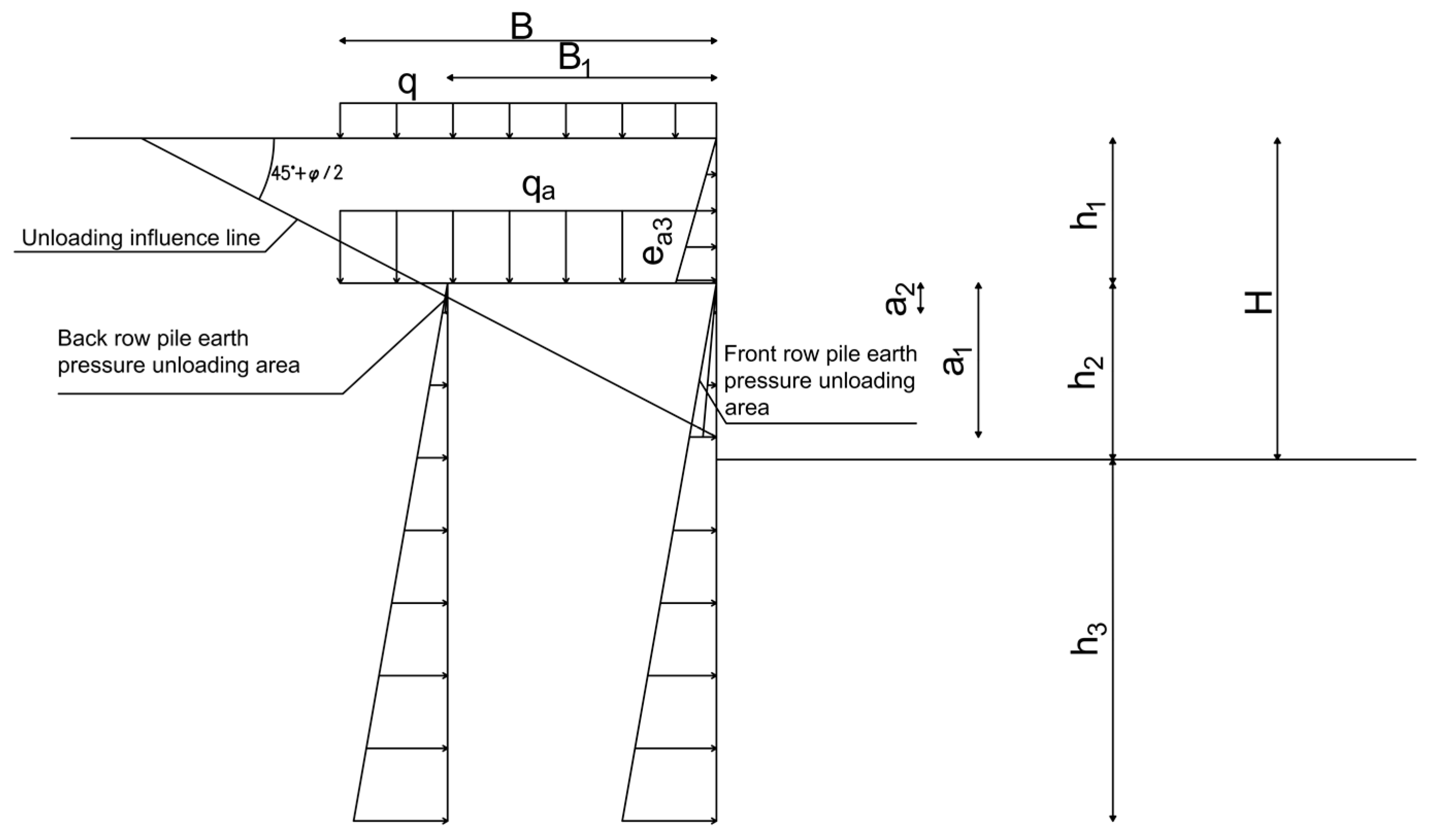

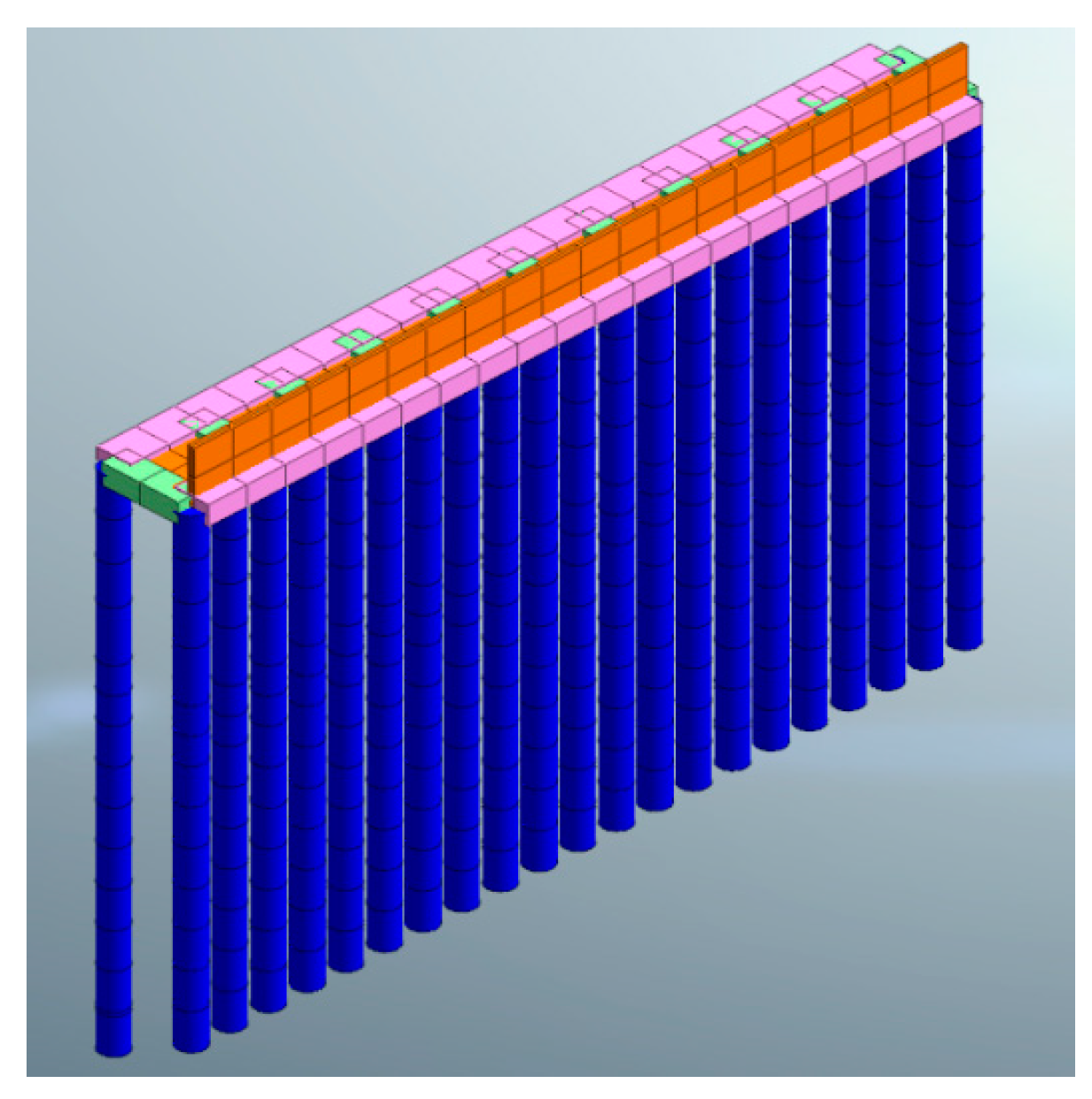
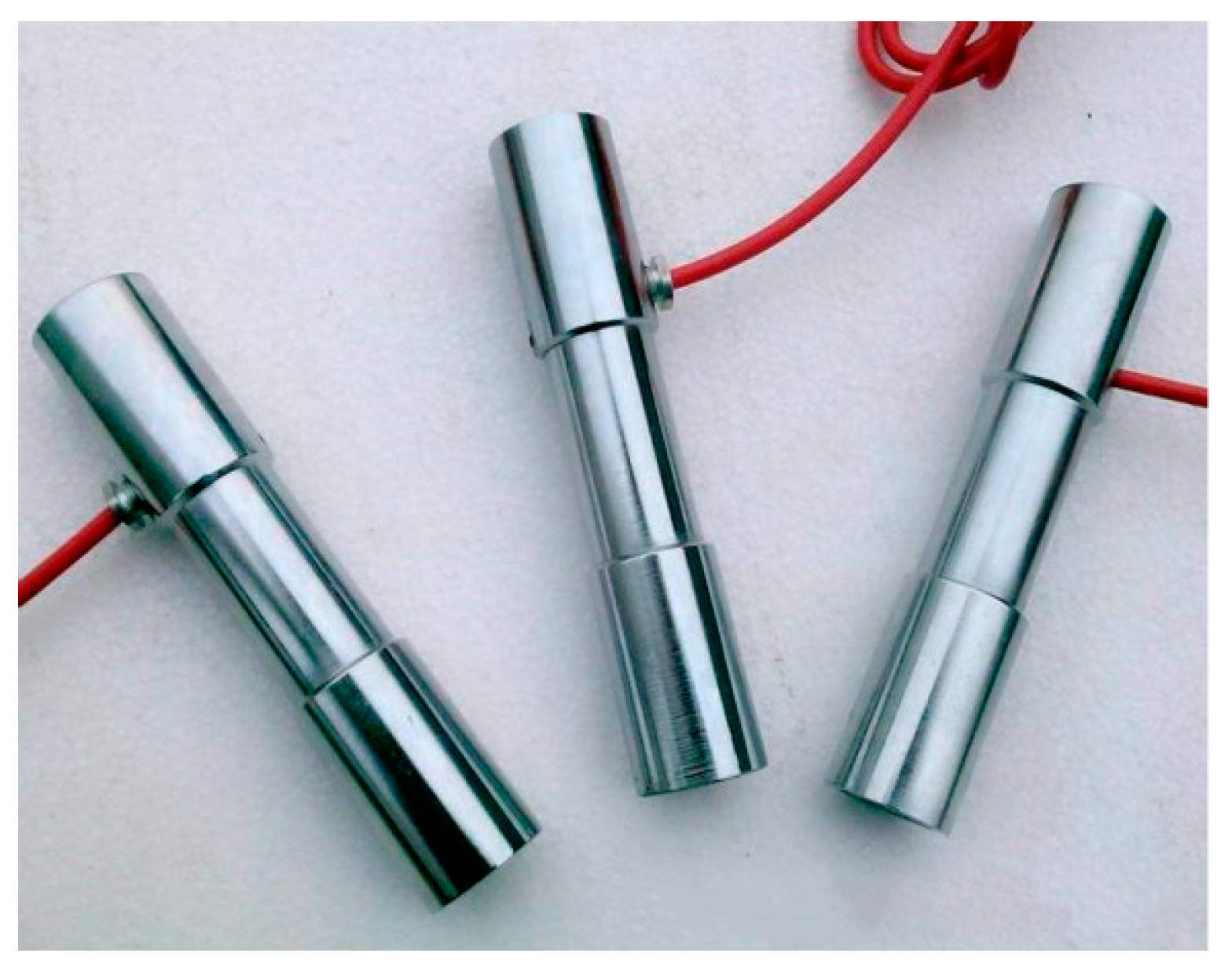

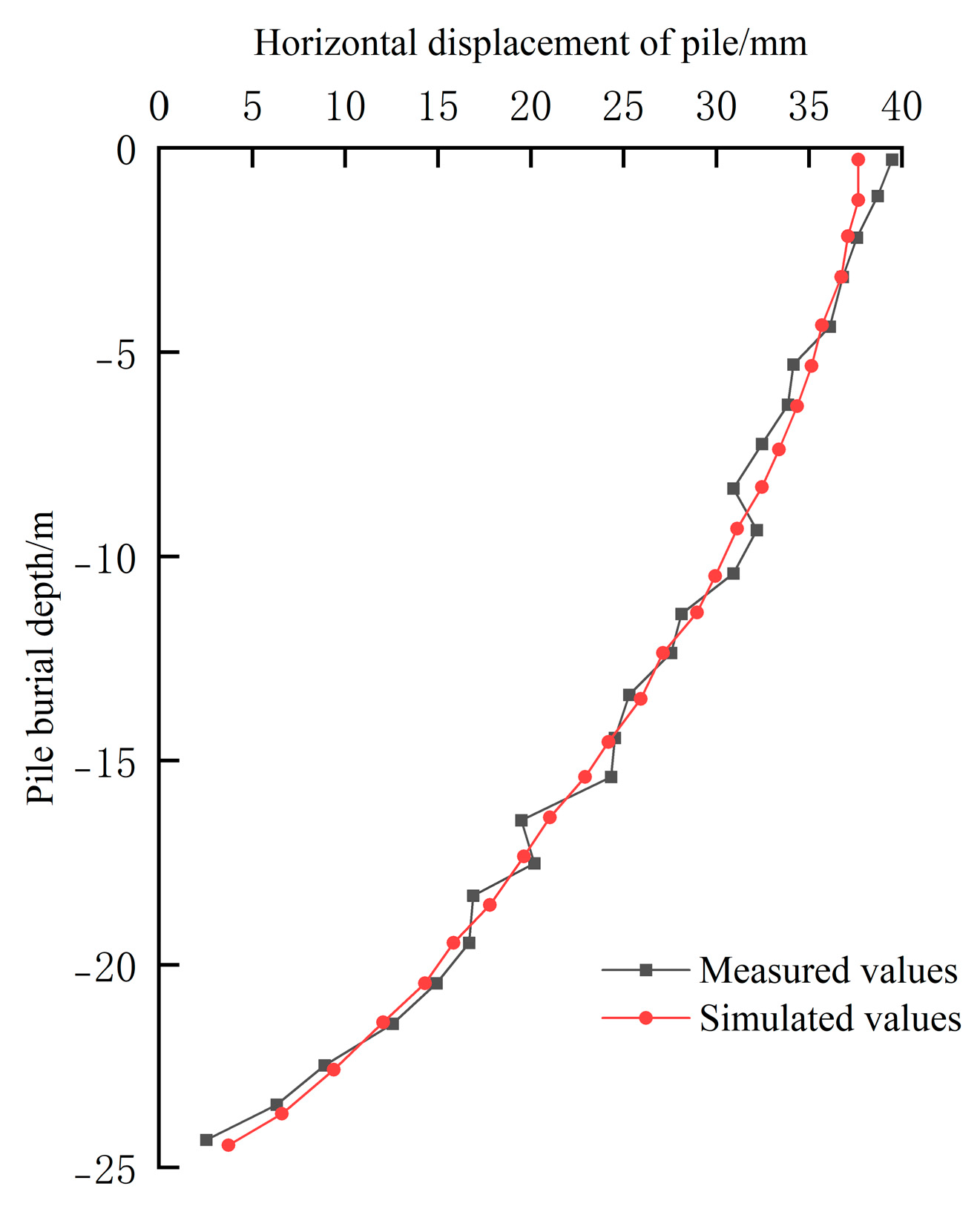
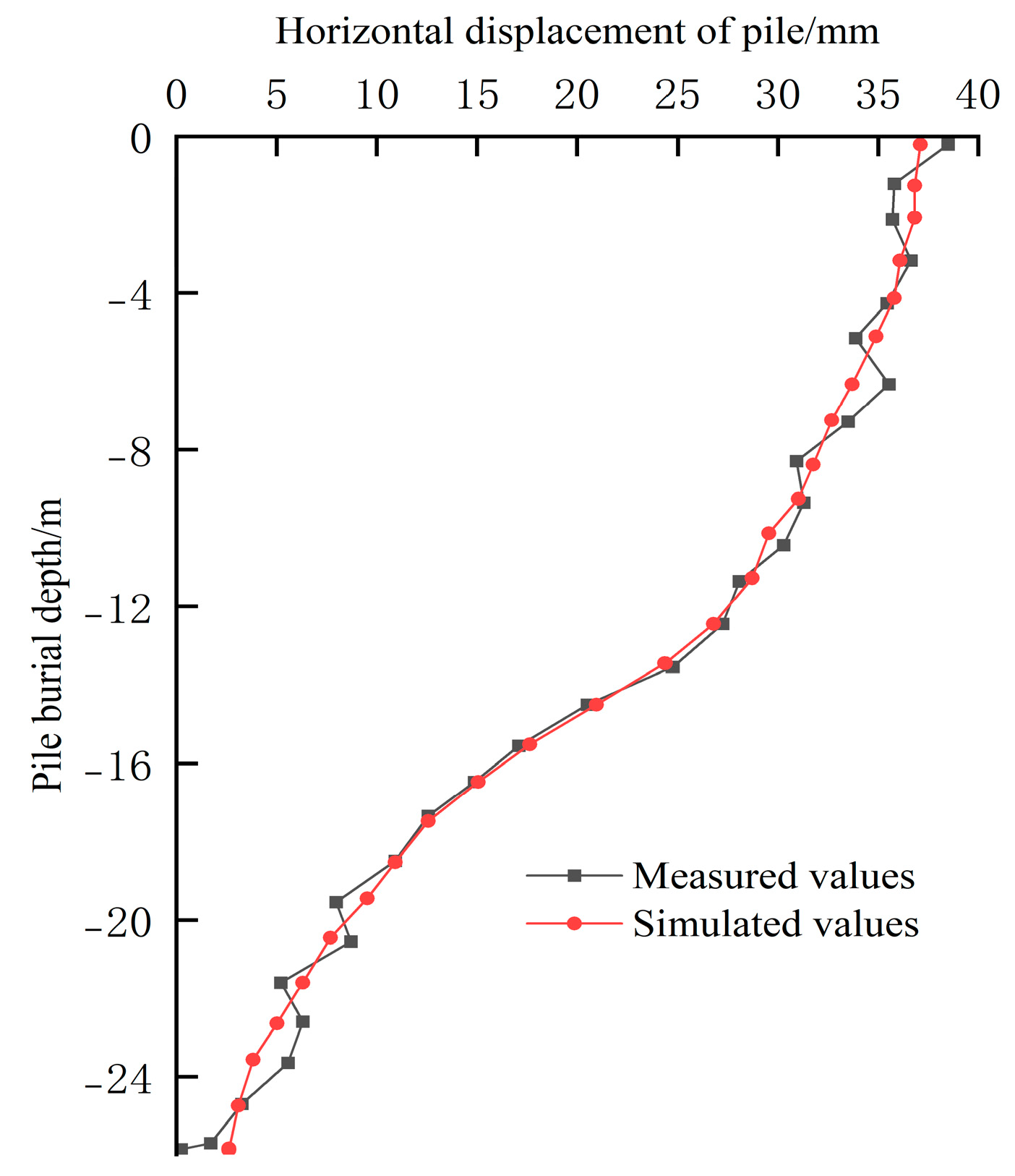
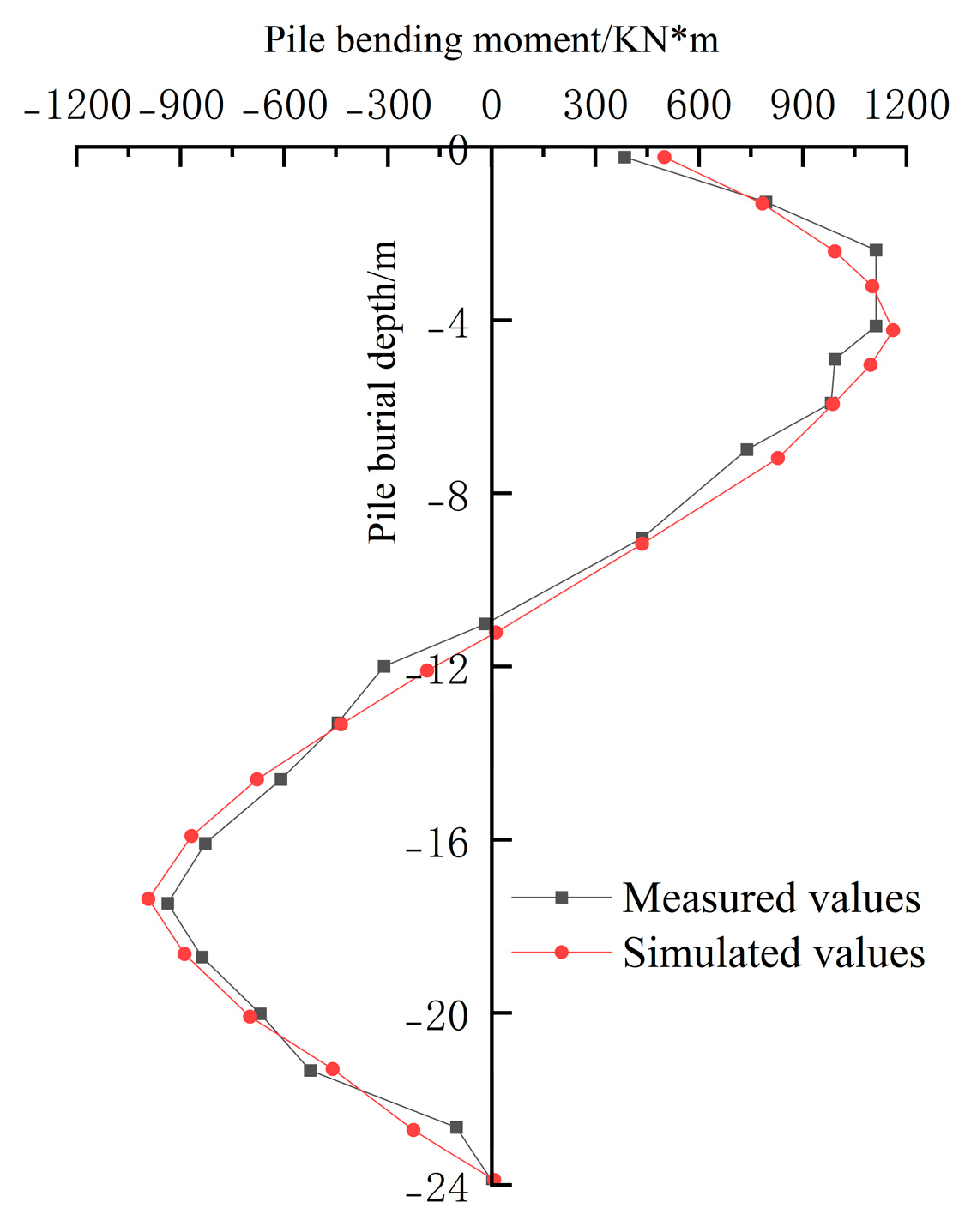
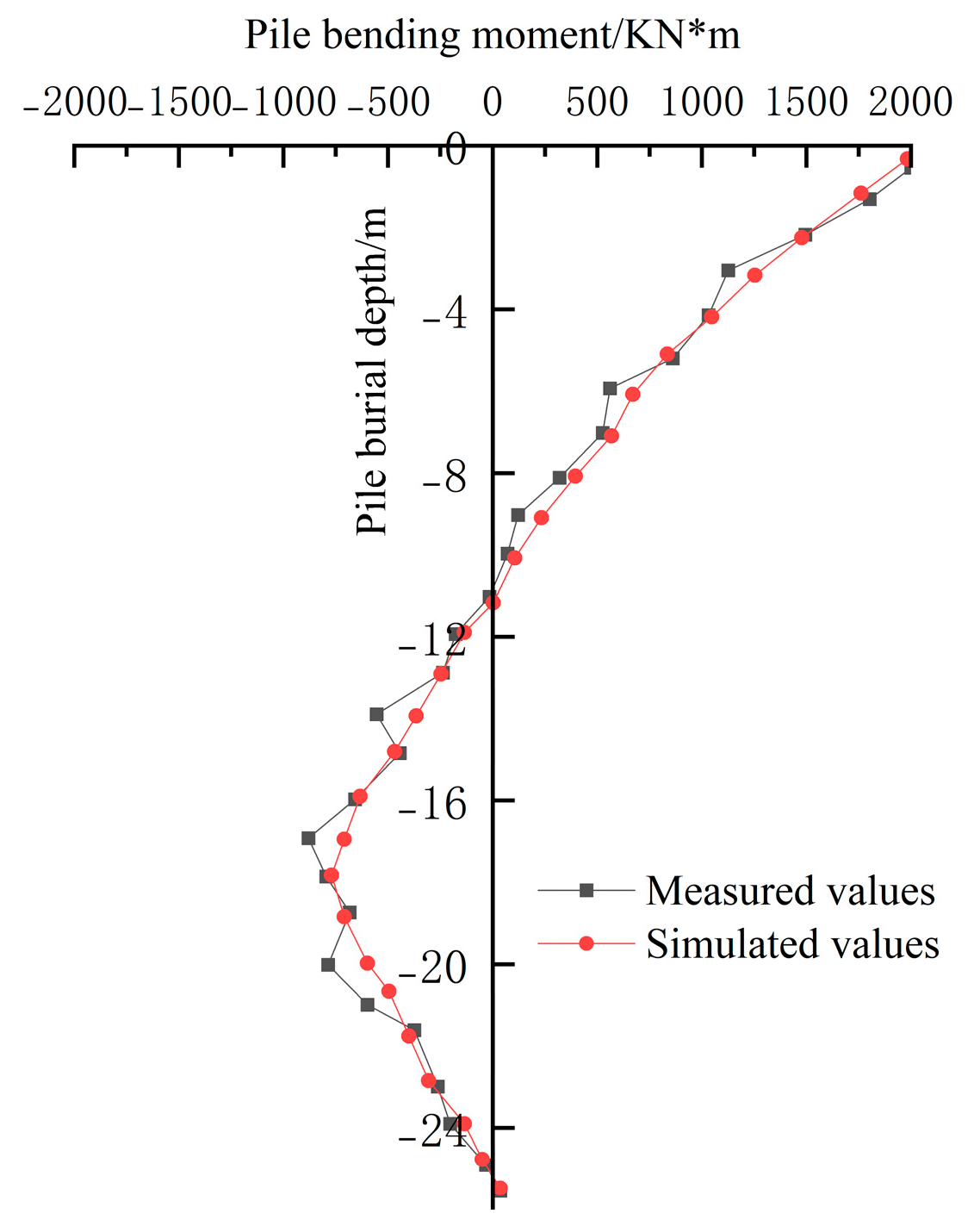
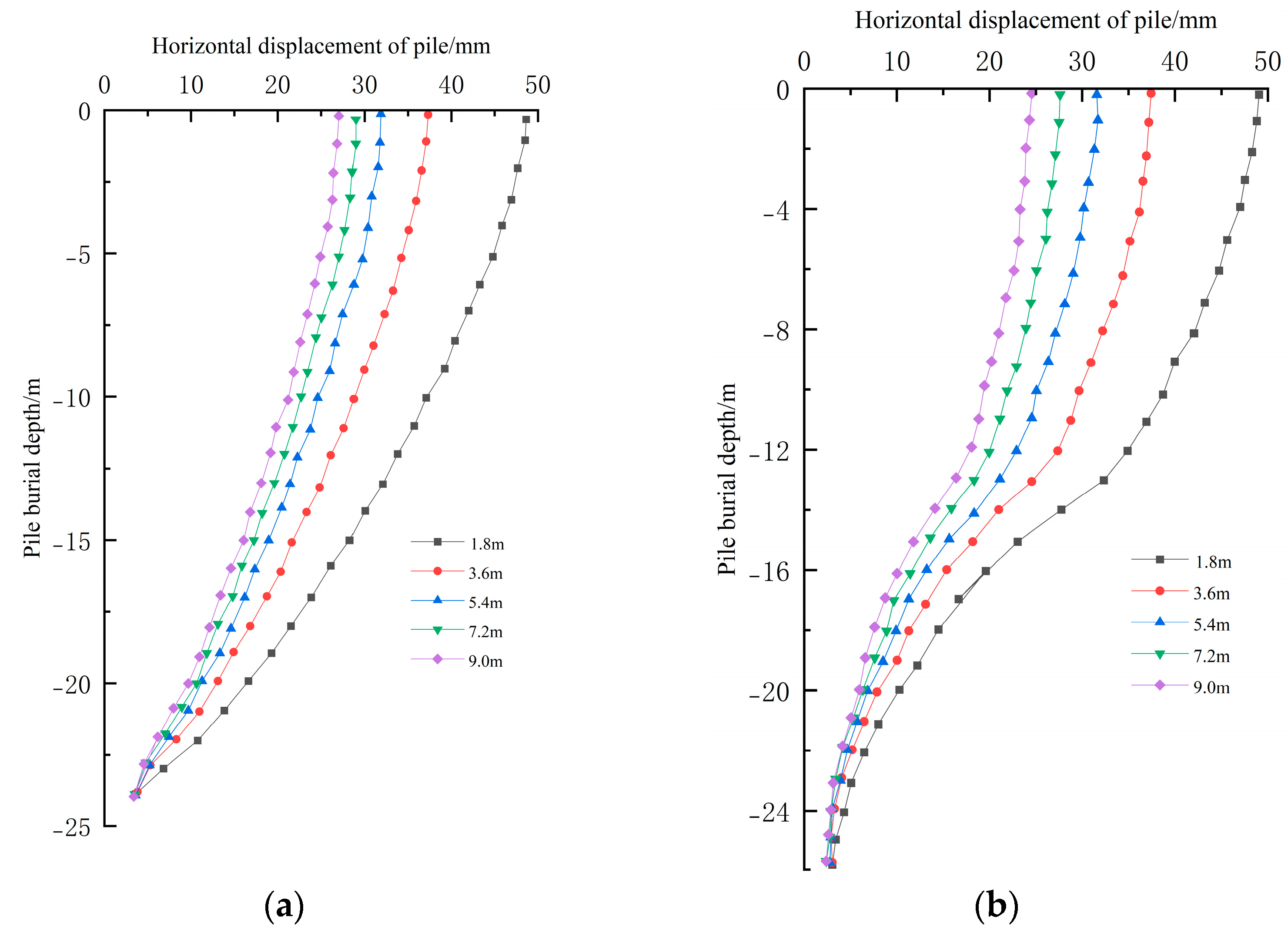
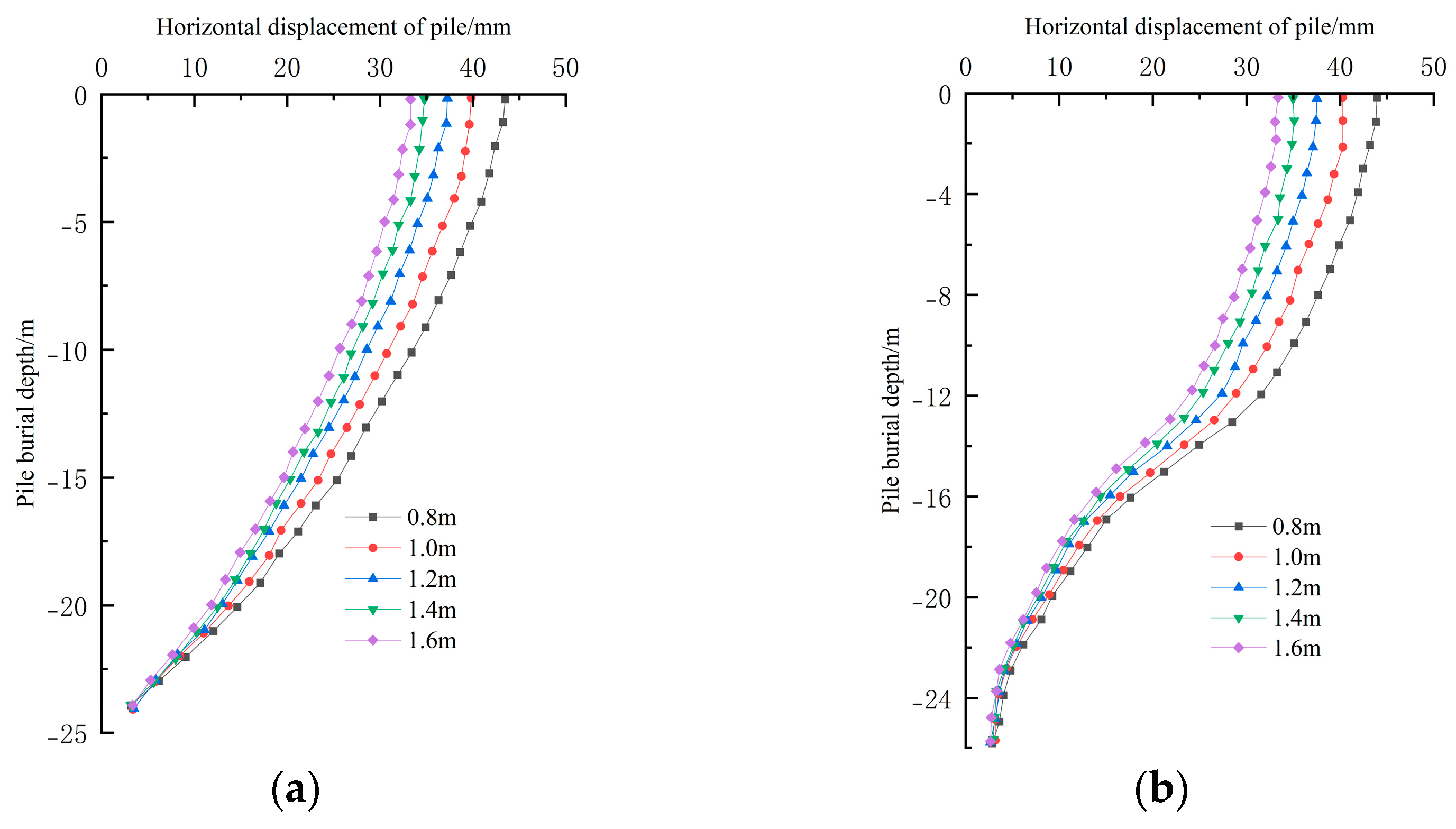
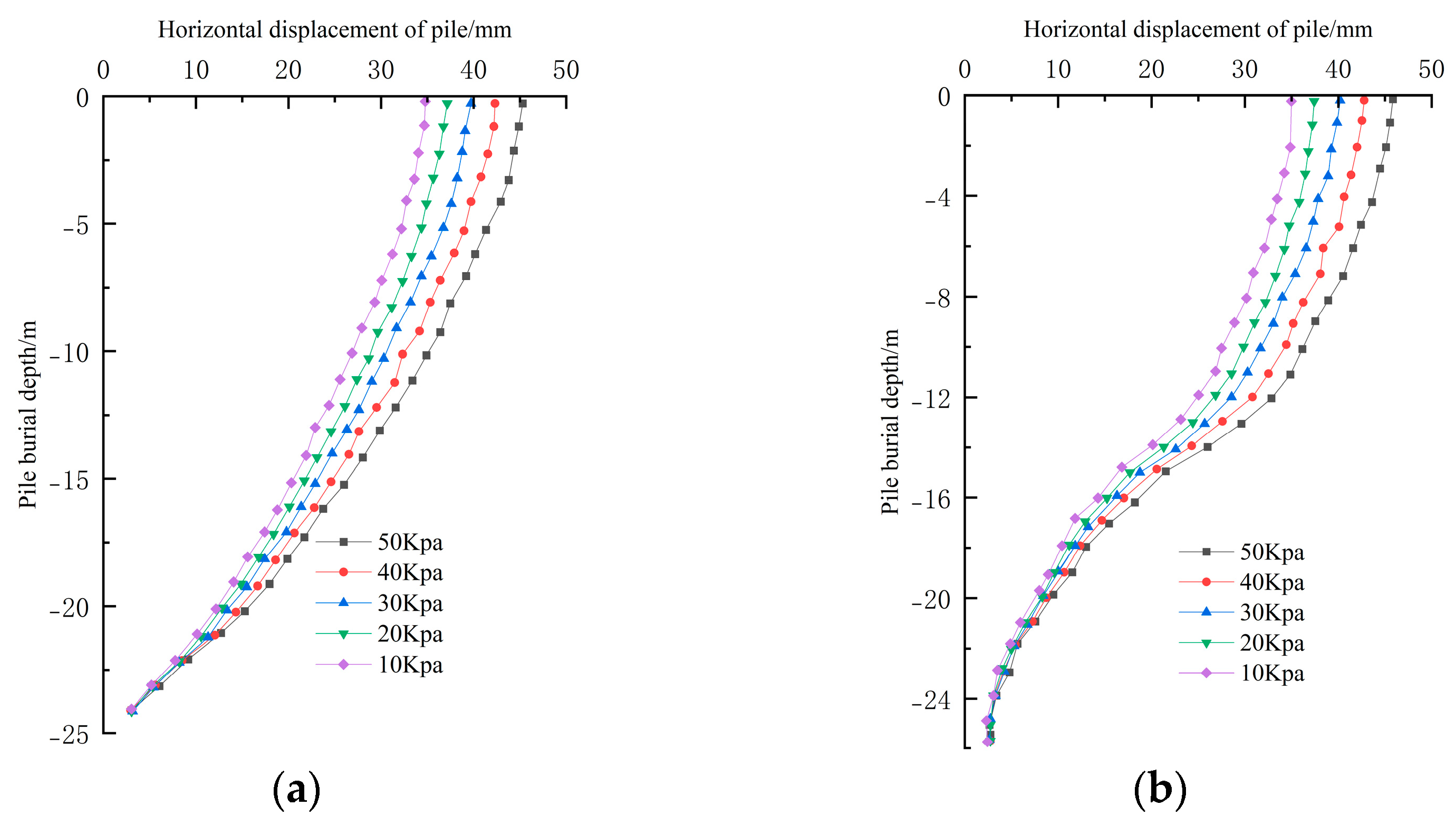
| Stratigraphic (Genetic) | Natural Weight (kN/m3) | Elasticity Modulus (MPa) | Cohesion (kPa) | Internal Friction Angle (°) | Permeability Coefficient (m/d) |
|---|---|---|---|---|---|
| 1-1 Rockfill (Q4mL) | 20.0 | 106 | 6 | 32 | 3.0 |
| 2-1 Silt (Qm) | 16.5 | 10 | 10 | 6 | 0.005 |
| 3-1 Silty clay (Q4al+pl) | 18.5 | 45 | 20 | 16 | 0.05 |
| 4-1 Gravel clay (Qel) | 18.5 | 54 | 21 | 23 | 0.1 |
| 5-1 Completely weathered granite (γK1) | 19.0 | 150 | 23 | 28 | 0.2 |
| 5-2 Strongly weathered granite (γK1) | 20.0 | 240 | 25 | 32 | 0.5 |
| Variable Parameter (Base Value) | Adjustment Range (m or kPa) |
|---|---|
| Row distance (3.6 m) | 1.8, 3.6, 5.4, 7.2, 9.0 |
| Diameter of back-row piles (1.2 m) | 0.8, 1.0, 1.2, 1.4, 1.6 |
| Top load (20 kPa) | 10, 20, 30, 40, 50 |
Disclaimer/Publisher’s Note: The statements, opinions and data contained in all publications are solely those of the individual author(s) and contributor(s) and not of MDPI and/or the editor(s). MDPI and/or the editor(s) disclaim responsibility for any injury to people or property resulting from any ideas, methods, instructions or products referred to in the content. |
© 2023 by the authors. Licensee MDPI, Basel, Switzerland. This article is an open access article distributed under the terms and conditions of the Creative Commons Attribution (CC BY) license (https://creativecommons.org/licenses/by/4.0/).
Share and Cite
Dong, B.; Wang, Q.; Ma, F.; Zhang, C.; Zou, L. Calculation Theory of Counterweight Double-Row Pile Support for Deep Foundation Pit in Reclamation Area and Influence Analysis of Core Pile Parameters. Sustainability 2023, 15, 6184. https://doi.org/10.3390/su15076184
Dong B, Wang Q, Ma F, Zhang C, Zou L. Calculation Theory of Counterweight Double-Row Pile Support for Deep Foundation Pit in Reclamation Area and Influence Analysis of Core Pile Parameters. Sustainability. 2023; 15(7):6184. https://doi.org/10.3390/su15076184
Chicago/Turabian StyleDong, Bo, Qiongyi Wang, Fenghai Ma, Cun Zhang, and Liang Zou. 2023. "Calculation Theory of Counterweight Double-Row Pile Support for Deep Foundation Pit in Reclamation Area and Influence Analysis of Core Pile Parameters" Sustainability 15, no. 7: 6184. https://doi.org/10.3390/su15076184




